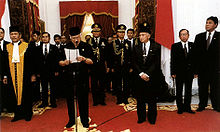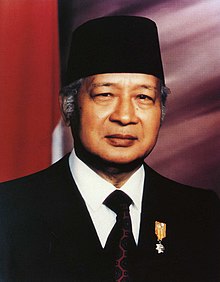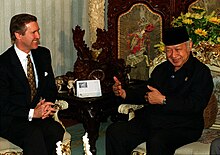Figurehead president
At this time, as part of compromise with the Dutch, Indonesia adopted a new federal constitution that made the country a federal state called the Republik Indonesia Serikat (Republic of United States of Indonesia), consisting of the Republic of Indonesia whose borders were determined by the "Van Mook Line", along with 6 states and 9 autonomous territories created by the Dutch. During the first half of 1950, these states gradually dissolved itself as the Dutch military that previously propped them, was withdrawn. On August 1950, with the last state - State of East Indonesia - dissolving itself, Sukarno declared a Unitary Republic of Indonesia based on newly-formulated provisional constitution of 1950. Both the Federal Constitution of 1949 and the Provisional Constitution of 1950 were parliamentary in nature, where executive authority laid with the prime minister, and which—on paper—limited presidential power. However, even with his formally reduced role, he commanded a good deal of moral authority as Father of the Nation.
The first years of parliamentary democracy proved to be very unstable for Indonesia. Cabinets fell in rapid succession due to the acute differences between the various political parties within the newly-appointed parliament (Dewan Perwakilan Rakjat/DPR). There was severe disagreements on future path of Indonesian state, between nationalists who wanted a secular state (led by Partai Nasional Indonesia first established by Sukarno), the Islamists who wanted an Islamic state (led by Masyumi Party), and the communists who wanted a communist state (led by PKI, only allowed to operate again in 1951). On the economic front, there was severe dissatisfaction with continuing economic domination by large Dutch corporations and the ethnic-Chinese.
In the regions, the Darul Islam rebels under Kartosuwirjo in West Java refused to acknowledge Sukarno's authority and declared a NII (Negara Islam Indonesia - Islamic State of Indonesia) on August 1949. Rebellions in support of Darul Islam also broke-out in South Sulawesi in 1951, and in Aceh in 1953. Meanwhile, pro-federalism members of the disbanded KNIL launched failed rebellion in Bandung (APRA rebellion of 1950), in Makassar in 1950, and in Ambon (Republic of South Maluku revolt of 1950).[21]
Additionally, the military was torn with hostilities between officers originating from the colonial-era KNIL, who wished for a small and elite professional military, and the overwhelming majority of soldiers who started their careers in the Japanese-formed PETA, who were afraid of being discharged and were more known for nationalist-zeal over professionalism.
On 17 October 1952, the leaders of the former-KNIL faction, Army Chief Colonel Abdul Haris Nasution and Armed Forces Chief-of-Staff Major-General Tahi Bonar Simatupang mobilized their troops in a show of force. Protesting against attempts by the DPR to interfere in military business on behalf of the former-PETA faction of the military, Nasution and Simatupang had their troops surround the Merdeka Palace and point the tank turrets in the direction of the said building. Their demand to Sukarno was that the current DPR be dismissed. For this cause, Nasution and Simatupang also mobilized civilian protesters. Sukarno came out of the palace and using nothing but his famed oratory skills, convinced both soldiers and civilians alike to go home. Nasution and Simatupang had been defeated, and both were later dismissed. Nasution, however, would be re-appointed as Army Chief after reconciling with Sukarno in 1955.
In 1954, Sukarno married Hartini, a 30-years-old widow from Salatiga, whom he met during a reception. His third wife, Fatmawati was outraged by this fourth marriage. She left Sukarno and their children, although they never officially divorced. Fatmawati no longer took-up the duties as First Lady, a role subsequently filled by Hartini.
 |
| Sukarno casting his vote at the 1955 elections |
The 1955 elections produced a new Parliament and a Constitutional Assembly. The election results equally shared power between the antagonistic powers of PNI, Masyumi, Nahdlatul Ulama, and PKI. Hence, domestic political instability continued unabated. Talks in the Constitutional Assembly to produce a new constitution met a deadlock over the issue of whether to include Islamic law.
On the international front, Sukarno organised the Bandung Conference in 1955, with the goal of uniting developing Asian and African countries into a non-aligned movement to counter against the competing superpowers at the time.
Sukarno resented his figurehead position and the increasing disorder of the country's political life. Claiming Western-style democracy was unsuitable for Indonesia, he called for a system of "guided democracy." The Indonesian way of deciding important questions, he argued, was by way of prolonged deliberation designed to achieve a consensus. This was the way problems were solved at the village level, and Sukarno argued it should be the model for the entire nation. He proposed a government based not only on political parties but on "functional groups" composed of the nation's basic elements, which would together form a National Council, through which a national consensus could express itself under presidential guidance.
Vice-President Mohammad Hatta was strongly opposed to Sukarno's guided democracy concept. Citing irreconcilable differences, Hatta resigned from his position in December 1956. Hatta's retirement sent a shockwave across Indonesia, particularly among the non-Javanese ethnicities, who viewed Hatta as their representative in a Javanese-dominated government.
From December 1956 to January 1957, regional military commanders in North Sumatera, Central Sumatera, and South Sumatera provinces took over local government control. They declared a series of military councils which will run their respective areas and refused to accept orders from Jakarta. A similar regional military movement took control of North Sulawesi on March 1957. They demanded the elimination of communist influence in government, equal share in government revenues, and reinstatement of Sukarno-Hatta duumvirate.
Faced with this serious challenge to the unity of the republic, Sukarno declared martial law (Staat van Oorlog en Beleg) on 14 March 1957. He appointed a non-partisan prime minister Djuanda Kartawidjaja, while the military was in the hands of his loyalist General Nasution. Nasution increasingly shared Sukarno's views on the negative impact of western democracy on Indonesia, and he foresaw greater role for the military to bring much-needed discipline to the country.
As a reconciliatory move, Sukarno invited the leaders of the regional councils to Jakarta on 10–14 September 1957, to attend a National Conference (Musjawarah Nasional), which failed to bring a solution to the crisis. On 30 November 1957, an assassination attempt was made by grenade attack against Sukarno when he was visiting a school function in Cikini, Central Jakarta. Six children were killed, but Sukarno did not suffer any serious wounds. The perpetrators were members of the Darul Islam extremist group, under the order of its leader Sekarmadji Maridjan Kartosuwirjo.
By December 1957, Sukarno began to take concrete steps to enforce his authority over the country. On that month, he nationalised 246 Dutch companies which have been dominating Indonesian economy (most notably the NHM, Royal Dutch Shell subsidiary Bataafsche Petroleum Maatschappij, Escomptobank, Internatio, Geo Wehry & Co, Jacobson & Berg, etc.) and expelled 40,000 Dutch citizens remaining in Indonesia while confiscating their properties, due to the failure by the Dutch government to continue negotiations on the fate of Netherlands New Guinea as was promised in the 1949 Round Table Conference. Sukarno's economic nationalism policy was followed by issuance Presidential Directive No. 10 of 1959, which banned commercial activities by foreign nationals in rural areas. This rule targeted the ethnic-Chinese, who dominated both the rural and urban retail economy despite the fact that at this time few of them had Indonesian citizenship. This policy resulted in massive relocation of the rural ethnic-Chinese population to urban areas, while approximately 100,000 chose to return to China.
To face the dissident regional commanders, Sukarno and Army Chief Nasution decided to take drastic steps following the failure of Musjawarah Nasional. By utilising regional officers that remained loyal to Jakarta, Nasution organised a series of "regional coups" which ousted the dissident commanders in North Sumatera (Colonel Maludin Simbolon) and South Sumatera (Colonel Barlian) by December 1957. This returned government control over key cities of Medan and Palembang.
On February 1958, the remaining dissident commanders in Central Sumatera (Colonel Ahmad Hussein) and North Sulawesi (Colonel Ventje Sumual) declared PRRI-Permesta Movement aimed at overthrowing the Jakarta government. They were joined by many civilian politicians from the Masyumi Party, such as Sjafruddin Prawiranegara who were opposed to growing influence of communists. Due to their anti-communist rhetoric, the rebels received monetary, weaponry, and manpower aid from the CIA until Allen Lawrence Pope, an American pilot, was shot down after a bombing raid on government-held Ambon on April 1958. On April 1958, central government responded by launching airborne and seaborne military invasions on Padang and Manado, the rebel capitals. By the end of 1958, the rebels have been militarily defeated, and the last remaining rebel guerilla bands surrendered on August 1961.
'Guided Democracy' and increasing autocracy
 |
Sukarno (on top of the steps) reading his decree
on 5 July 1959 |
The impressive military victories over the PRRI-Permesta rebels and the popular nationalisation of Dutch companies left Sukarno in a very strong position. On 5 July 1959, Sukarno reinstated the 1945 constitution by presidential decree. It established a presidential system which he believed would make it easier to implement the principles of guided democracy. He called the system Manifesto Politik or Manipol—but was actually government by decree. Sukarno envisioned an Indonesian-style socialist society, who adhere to the principle of USDEK:
- Undang-Undang Dasar '45 (Constitution of 1945)
- Sosialisme Indonesia (Indonesian socialism)
- Demokrasi Terpimpin (Guided Democracy)
- Ekonomi Terpimpin (Commanded Economy).
- Kepribadian Indonesia (Indonesia's Identity)
 |
| The structure of Sukarno's guided democracy in 1962 |
On March 1960, Sukarno disbanded parliament and replaced it with a new parliament where half the members were appointed by the president (Dewan Perwakilan Rakjat - Gotong Rojong / DPR-GR). On September 1960, he established a Provisional People's Consultative Assembly (Madjelis Permusjawaratan Rakjat Sementara/MPRS) as the highest legislative authority according to the 1945 constitution. MPRS members consisted of members of DPR-GR and members of "functional groups" appointed by the president.
With the backing of the military, Sukarno disbanded the Islamic party Masyumi and Sutan Sjahrir's party PSI, accusing them of involvement with PRRI-Permesta affair. The military arrested and imprisoned many of Sukarno's political opponents, from socialist Sjahrir to Islamic politicians Mohammad Natsir and Hamka. Using martial law powers, the government closed-down newspapers who were critical of Sukarno's policies.
During this period, there were several assassination attempts on Sukarno's life. On 9 March 1960, Daniel Maukar, an Indonesian airforce lieutenant who sympathised with the Permesta rebellion, strafed the Merdeka Palace and Bogor Palace with his MiG-17 fighter jet, attempting to kill the president; he was not injured. On May 1962, Darul Islam agents shot at the president during Eid al-Adha prayers on the grounds of the palace. Sukarno again escaped injury.
On the security front, the military started a series of effective campaigns which ended the long-festering Darul Islam rebellion in West Java (1962), Aceh (1962), and South Sulawesi (1965). Kartosuwirjo, the leader of Darul Islam, was captured and executed in September 1962.
To counterbalance the power of the military, Sukarno started to rely on the support of the Communist Party of Indonesia (PKI). In 1960, he declared his government to be based on Nasakom, a union of the three ideological strands present in Indonesian society: nasionalisme (nationalism), agama (religions), and komunisme (communism). Accordingly, Sukarno started admitting more communists into his government, while developing strong relationship with the PKI chairman Dipa Nusantara Aidit.
In order to increase Indonesia's prestige, Sukarno supported and won the bid for the 1962 Asian Games held in Jakarta. Many sporting facilities such as the Senayan sports complex (including the 100,000-seat Bung Karno Stadium) were built to accommodate the games. There was political tension when the Indonesians refused the entry of delegations from Israel and Taiwan. After the International Olympic Committee put sanctions on Indonesia due to this exclusion policy, Sukarno retaliated by organising a "non-imperialist" competitor event to the Olympic Games, called Games of New Emerging Forces (GANEFO). GANEFO was successfully held in Jakarta on November 1963, and was attended by 2,700 athletes from 51 countries.
As part of his prestige-building program, Sukarno ordered the construction of large monumental buildings such as National Monument (Monumen Nasional), Istiqlal Mosque, CONEFO Building (now the Parliament Building), Hotel Indonesia, and the Sarinah shopping centre to transform Jakarta from a former colonial backwater to a modern city. The modern Jakarta boulevards of Jalan Thamrin, Jalan Sudirman, and Jalan Gatot Subroto was planned and constructed under Sukarno.
Read Soekarno Part III
Read More

















